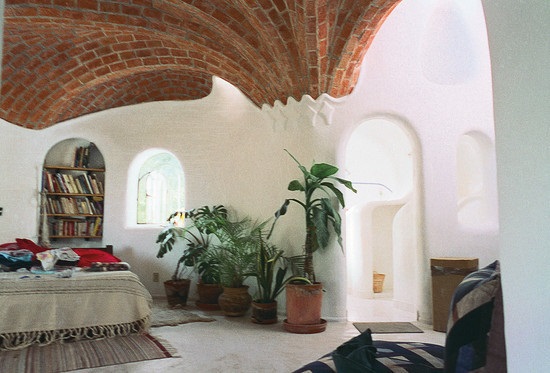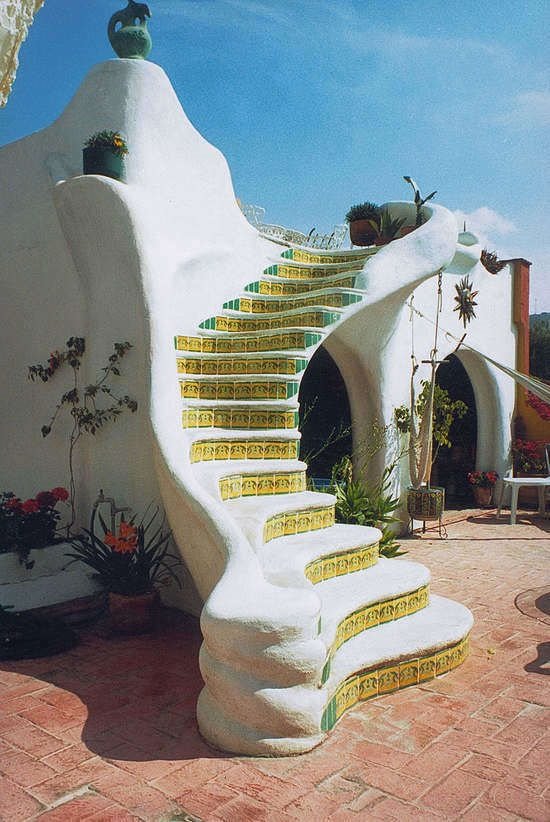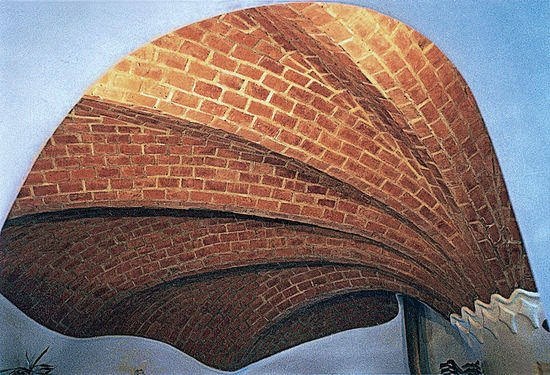Below is an excerpt from Home Work: Hand Built Shelter (Shelter Publications, 2004) by Lloyd Kahn. This book features more than 1,500 photos that illustrate various innovative architectural styles and natural building materials such as cob, papercrete, bamboo, adobe, strawbale, timber framing and earthbags. If you love fine, fun or funky buildings, you will enjoy this book. The earthbag home that I built in Colorado was featured in it.
Steve Kornher worked with adobe and rammed earth as well as various types of concrete masonry construction. He is now “completely in love with lightweight volcanic aggregate.” Here is his account and photos of his latest work.
My wife, Emilia, and I live on a 2-acre ranchito about 25 minutes from San Miguel de Allende, in the mountains of central Mexico (6,200 feet elevation). Our home is a work in progress: built Mexican style, pay as you go, and leave the re-bar sticking out for future additions. We built the house and large warehouse over a period of two years, using two (sometimes three) masons at a time. Building slowly is a lot more enjoyable and you can be more creative, since you can think things over and make changes.
The house presently has about 1,200 square feet (110 square meters) of interior space with plenty of terraces for outdoor living. Most of the first floor is of adobe construction. Later, additions and roofs were added made of lightweight volcanic aggregate. South-facing windows and an overhang provide passive solar heat in the wintertime. All roofs are masonry vaults with shell motifs. Mexico has some great masons, and I owe a lot to the knowledgeable maestros who have helped me figure out how to do this wild and crazy stuff.
One of my main goals is low-cost building construction that lasts 400 years. To accomplish that in this climate, you need to build self-supporting structures and use masonry construction adobe, lightweight concrete block, reinforced concrete columns, and other features. The roof is the key to long building life, so it needs to be self-supporting, roundie-curvie — and not flat. Self-supporting vertical walls by nature want to be roundie-curvie. You go on from there and pretty soon everything is roundie-curvie.
When you start to think about a long-lasting house, it’s best to build so that remodeling is possible (probable). With adobe and/or lightweight concrete construction, you can hack out a doorway later on. With hard concrete, this is an almost impossible project.
I have worked with a lot of different forming systems for different roofs. The largest to date is approximately 6 meters by 6 meters. Small roofs can be supported from above during construction, but larger roofs need some center support.
Designing a smart roof shape is one key. Roofs in barrel vaults, modified domes, and especially seashell shapes (my favorites, and actually quite easy to do) are all very strong in compression. Because the roofs are self-supporting in shape and poured slowly, very little reinforcing is necessary. Once a lower form mold is made-up — typically pieces of 3/8-inch re-bar or welded wire — it can be easily moved in sections to form an identical roof.
Roofs are all built with an initial 3/8-inch shell poured on plaster lath on top of a metal framework (which is later removed and reused). This shell stiffens everything up for the pours of lightweight aggregate which follow and lets you see what the roof will look like. Changes are easy at this point. After the roof pour (4 to 6 inches thick), you can move the form again in five or six days for the next roof. I’m a big fan of reusable and movable formwork, usually 3/8-inch re-bar and/or #10 or #6 welded wire.
Walls are typically 6 to 8 inches thick in my environment, built from the same volcanic aggregate. At first, I poured the aggregate into forms: 8-to-1 ratio of aggregate-to-cement by volume for walls; 5-to-1 ratio for roofs. But now blocks are being made locally and because they are quicker, I use them for even roundie-curvie walls.
Concrete is strong in compression. The best way to take advantage of this property is by building structures that are inherently self-supporting and don’t need a lot of iron reinforcing. Because most building here in my part of Mexico is with concrete, it is easier to let your imagination go wild. Local builders have been working with ferro-cement, wired Styrofoam panels, plastered straw bales, and soil-crete.
I have had the most success with lightweight concrete. Lightweight concrete differs from heavy concrete by its use of naturally lightweight materials (aggregates), such as pumice (volcanic stone) in place of the sand and gravel used in ordinary structural concrete mixes. It weighs only half as much: 50 to 80 pounds per cubic foot.
Not all concrete is ugly, hard, cold, and difficult to work with. There exists a whole range of lightweight concretes “which have a density and compressive strength very similar to wood. They are easy to work with, can be nailed with ordinary nails, cut with a saw, drilled with woodworking tools, and easily repaired. 
Some form of suitable aggregate is available most everywhere in the world. Our locally available aggregate here in San Miguel is a type of pumice or scoria, called espumilla or arenilla in local Spanish, which we typically mix 8-to-1 with cement for walls or 5-to-1 for roofs.
Most lightweight concrete has a good R-value and is a good insulator of heat and sound. It is used as soundproofing in subway stations. It has tremendous sculptural possibilities and is ideal for monolithic, wall-roof construction.
I feel that we need more intelligent building systems. I’m looking for a home that lasts several hundred years, that you can maintain and remodel easily, and that uses mostly locally available, abundant materials. Lightweight concrete fits the bill.
Steve Kornher’s website is www.flyingconcrete.com

OH HOW BEAUTIFUL!
thank you for sharing this, Kelly.